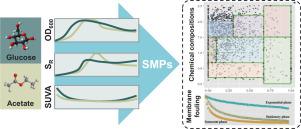Water Research ( IF 11.4 ) Pub Date : 2021-01-13 , DOI: 10.1016/j.watres.2021.116835 Xiaofang Yang , Danyi Li , Zhong Yu , Yabing Meng , Xing Zheng , Shanshan Zhao , Fangang Meng

|
The complexity of production process and chemical compositions of soluble microbial products (SMPs) largely limits the understanding of membrane fouling in membrane bioreactors (MBRs). Herein, we used a model single-strain Escherichia coli to better understand the chemical natures of SMPs and their roles in membrane fouling. The effects of carbon source and growth phase on the chemical compositions of SMPs were identified at both the compound and molecular levels by using advanced techniques including excitation emission matrix and parallel factor analysis (EEM-PARAFAC), size exclusion chromatography coupled with organic carbon detection (LC-OCD), and untargeted ultra-performance liquid chromatography - Q-Exactive - mass spectrometry (UPLC-Q-Exactive-MS). Subsequently, the roles of SMPs in the propensity of membrane fouling during ultrafiltration (UF) were studied. The results showed that the chemical compositions and fouling potentials of SMPs were carbon source- and growth phase-dependent. In the exponential phase, SMPs mainly consisted of utilization-associated products (UAPs) and remaining substrates. As the microorganism progressed into the stationary and senescent phases, UAPs and biomass-associated products (BAPs) were the main components, respectively. The SMP contents generated in glucose medium were higher than those generated in acetate medium, and higher abundances of humic fluorescent components were observed in glucose-fed SMPs. Van Krevelen diagrams of the UPLC-MS results revealed that acetate-fed SMPs contained more carboxylic-rich alicyclic molecules, peptides-like, aromatic, and carbohydrates-like components than glucose-fed SMPs in the stationary and senescent phases. These components played a significant role in irreversible membrane fouling, as evidenced in UF experiments. Standard blocking and cake filtration were the main fouling mechanisms for the filtration of SMPs collected in the exponential and stationary/senescent phases, respectively. Our findings highlight linkages between SMP compositions and membrane fouling at both the compound and molecular levels and suggest that both the carbon source and growth phase strongly determine the production potential, chemical nature, and fouling behavior of SMPs.
中文翻译:

大肠杆菌生命周期中可溶性微生物产物的生化特性和膜污染行为
生产过程的复杂性和可溶性微生物产品(SMP)的化学成分在很大程度上限制了对膜生物反应器(MBR)中膜污染的理解。在本文中,我们使用了模型单株大肠杆菌以便更好地了解SMP的化学性质及其在膜污染中的作用。通过使用先进的技术,包括激发发射矩阵和平行因子分析(EEM-PARAFAC),尺寸排阻色谱法与有机碳检测相结合,在化合物和分子水平上鉴定了碳源和生长期对SMPs化学成分的影响( LC-OCD)和非靶向超高效液相色谱-Q-Exactive-质谱(UPLC-Q-Exactive-MS)。随后,研究了SMP在超滤(UF)过程中膜污染倾向中的作用。结果表明,SMPs的化学组成和结垢潜力与碳源和生长阶段有关。在指数阶段 SMP主要包括与利用相关的产品(UAP)和剩余的底物。随着微生物进入静止期和衰老期,UAP和生物质相关产品(BAP)分别是主要成分。葡萄糖培养基中产生的SMP含量高于乙酸盐培养基中产生的SMP含量,在葡萄糖喂养的SMP中观察到较高的腐殖质荧光成分。UPLC-MS结果的Van Krevelen图显示,在固定相和衰老相中,与葡萄糖喂养的SMP相比,乙酸喂养的SMP包含更多的富含羧基的脂环族分子,类似肽的,芳香的和类似碳水化合物的成分。如超滤实验所证明,这些成分在不可逆膜结垢中起着重要作用。标准的堵塞和滤饼过滤是分别过滤指数阶段和固定/衰老阶段收集的SMP的主要污垢机理。我们的发现突出了化合物和分子水平上SMP组成与膜污染之间的联系,并表明碳源和生长期都强烈决定了SMP的生产潜力,化学性质和污染行为。











































 京公网安备 11010802027423号
京公网安备 11010802027423号